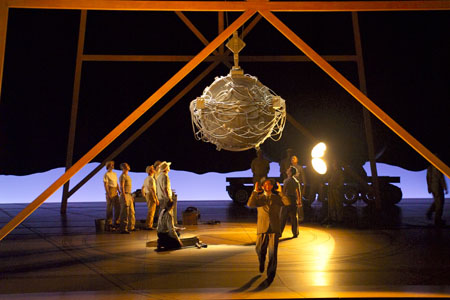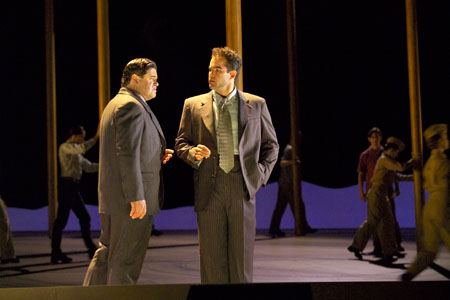|
Not with a bang, but a whimper, a very long, very noisy whimper. I spent three hours waiting for something to happen, something to be exciting, to be moving, transformative in the way grand opera must be in order to be effective. This was three hours of nervous static, loud, monotonous music, cardboard figures that never came anyway near to being "characters," busy stage business lacking dramatic impact.
The long-winded and short-of-breath affair may have to something to do with the fact that Doctor Atomic was not only an opera by commission but the topic, too was commissioned. I am sure a lot of brainwork and calculation went into it, but I didn't detect any creative urgency or should I say, passionate engagement in this affair, either by the composer John Adams or the librettist/ director Peter Sellars. Just think of Wagner after his stormy voyage to London in 1839, tearing the Flying Dutchman out of his chest in one explosive sweep. There is (literally) nothing that explodes in Doctor Atomic.
I have not been enthralled in the past by Sellars' hyperactive opera modernizations, nor by Adams' "political" operas. I found Nixon in China and The Death of Klinghoffer musically flat and dramatically boring. In Doctor Atomic, Adams comes up with two enticing preludes to his two acts, and a few effective final minutes, where he mixes sounds from the era, radio news, pop hits, human voices and machine noise electronics into an interesting acoustic blend. The rest of the time, he unfortunately limits himself to the orchestra and "quotes" from powerful sources. In the lyrical or eerie parts, there is always Benjamin Brittan with, for example, almost "verbatim" melodic lines from The Turn of the Screw. When intensity is called for, Stravinsky and Varese are waiting in the wings. In peak moments, like when the machinery of the atomic launch cranks up, Wagner lends a helping hand with clanking à la Siegfried's hammering, followed by Fafner's menacing roar. I could go on with the list.
I often wished Adams would go much further into these quotations and allow us some pleasure that way. But he seems to be afflicted with the "modernist's" need to battle any impulse toward beauty. Any time he dares to create a lyrical line or even a melodic lift he quickly puts in the damper of an ugly, anti-climactic note or boring ending to throttle the inspiration. After Doctor Atomic, I would advise Adams to take on the challenge of a purely emotional topic - as a liberation exercise. In the meantime, I can see him do an excellent job for the next Hollywood Star Wars series or other sci-fi suspense dramas. It's just too bad that there is no drama and not much suspense in Doctor Atomic – apart from the bad weather. The weather, perhaps the most prominent dramatis persona, plays a major role in the opera as it threatens at length to spoil the first test of the bomb.
Peter Sellars did not really write a libretto. He patched together a collage of texts, culled from all kinds of sources. The dialogue mostly consists of quotes from memoirs, diaries, biographies and US classified documents. We get a lot of small talk - a kind of continuous, dry "recitative" between Oppenheimer and his team members about the weather, their nerves and diets, and all the uncertainties of toying with the unknown nuclear power. But we don't get to know anybody. Least of all 'Dr. Atomic'. I could have imagined, let's say, the celestial beauty of mathematical formulas or the uncanny journey into a nucleus being sung by the father of the bomb. I could have been interested in the man through psychological insights, scientific arguments, political polemics, philosophical probings, moral challenges, you name it. We hear a few disturbing facts about the larger climate before the test and the planned military use of Oppenheimer's "Gadget" (the code name for the bomb) in Hiroshima and Nagasaki. There is talk about political and military pressure, and there is some doubt and dissent by members of the team. The humane idea of warning the Japanese about the expected effects of the bomb, in order to give them a reason and a chance to surrender, is rejected out of hand by Oppenheimer himself.
 |
He wants to stay out of politics and leave it to the Father-knows-best government that is eager to make a "profound psychological impression" on the Japanese. Some scientists, like young idealist Robert Wilson, want to petition Truman or make sure, in case of a catastrophic chain reaction, that the people at the Los Alamos test site can be evacuated. But the military won't have any of it and is standing by to guarantee secrecy and success at all cost, already suspicious of "our high-strung director" who might have a break-down in the last minute and somehow ruin their martial plans...
All of this sounds ten times more suspenseful written here (and in the program notes) than it comes across on the stage. The few main players, Oppenheimer's rival Edward Teller (sung by Richard Paul Fink), Robert Wilson (Thomas Glenn), the bomb's co-producer General Leslie Groves (Eric Owens), a meteorologist and a medical advisor exchange reports with their director about what is going on while they are waiting. Two or a few of the men take position up front and do their reporting. Nothing much happens. People behind them are working in what looks like a barn, at tables that look like kitchen table labs; some crowds form; dancers whirl and run among them with the well-known limited modern dance language of Lucinda Childs (who long ago had more impact in Bob Wilson's Einstein on the Beach), or do silly mime representations of automated labor. They all seem at times afraid. But Oppenheimer, apart from his nervous smoking, does not seem to be in any real conflict (and there is no fore-shadow of the drama that would soon follow when Edward Teller set out to destroy him as a leftie). Basically they all agree (never a good recipe for drama!) in wanting to see what they have created - most eagerly, and with a lot of poetry unleashed, Oppenheimer himself.
In Act I, Sellars presents his Dr. Atomic as an ambitious, pushy, tough guy. The singer (clear-toned Canadian baritone Gerald Finley), who has an unfortunate resemblance with Arnold Schwarzenegger, is made to look like a would-be politician with a bite, strutting his energetic chin and grey office suit, spewing optimism to keep his doubtful team in line. In the later scenes at the test site, perhaps because of the desert sun, he dons a hat and develops some doubts, which makes him appear more like a down-on-his-luck gumshoe in a B-movie.
 |
"You can't stop now," he reassures himself. "You want to know if it works..." Excuse me, but this is the brilliant, highly cultivated scientist who carried the Bhagavad Gita in his pocket? Well, Sellars had that in mind, too. "Oppie" uses every occasion for reflection as an excuse to recite some lines of wisdom from the poets and philosophers of old. But his creator doesn't seem to realize that all these recitations of "world poetry" only create dissociations because "nobody is home." The device backfires into pseudo-spiritual kitsch (I was waiting for Rumi to make an appearance), especially when all this high-faluting stuff comes from "Dr. Gumshoe."
The most absurd silliness is the bedroom scene where "Oppie" tries to read his book while, guess what? wife Kitty tries to seduce him.
Poor mezzo Kristine Jepson has to crawl around the bed to get at him and still sing to the audience. The clumsy maneuvers finally get him interested and whoosh! they swoon in Baudelaire land where "the odor of tobacco mixes with opium and sugar, tar, musk and coconut oil..." If only. For a second, "Oppie" ends up on top of Kitty, with the bed covers still between them, after which she angrily storms off. Could it be that Dr. Atomic could only get it up with the bomb?
The same awkwardness of directing afflicts Kitty, in real life a notorious alcoholic, in her solo, alone with a crib, a glass and a bottle. Overhead, the fat grey ball of the bomb, decorated with wires, hangs suspended like a chandelier.
If it was me in that room, I'd take a swig right out of the bottle, I can tell you that. But Sellars' Kitty holds the bottle in a way one would only carry a bottle of Evian around, and she seems undecided whether she is a frustrated drunken housewife or a sober Cassandra shouting out mad poetry by Oppenheimer's one-time classmate Muriel Rukeyser. When Kitty ambiguously rhapsodizes about "fierce peace" without stumbling over her own feet, is she for or against her genius husband's experiments?
Sellars won't tell. He apparently couldn't quite make up his mind about these people and their feelings. Or rather, they aren't supposed to be real people with real feelings. Apparently Adams and Sellars wanted to go for the "archetypal," but they ended up with the lowest common denominator - stereotype instead of archetype. Oppenheimer and all the other protagonists are stereotypes because the libretto, the music and the stage production are not able to endow them with lived human experience. Or call it soul. The women (Sellars invented a native Indian, the nanny, sung by mezzo Beth Clayton, as some sort of voice of token nature wisdom) don't exist. They certainly don't exist in any sense of a counter-force to the rational obsessions of the men. The male creators of this opera did not seem to perceive the glaring meaning of the atomic bomb as triumphant domination of man over nature. Through the revelation of the atom these scientists believed they had wrested all the secrets from nature, and now they were doing their own act of "creating" by forcing the atom apart - for maximum destruction.
If there is no drama, no ethical, moral, political questioning and probing in Doctor Atomic, what's the point? This opera about the release of energy plays more like a black hole sucking the potential energy of its themes into itself, leaving the audience depleted. When I looked at the opera patrons around me every now and then, I saw them crumpled in their seats, crushed, perhaps asleep, when they should have been at the edge of their seats. I wondered: Is there any meaning to this enterprise?
A fashionable British general director and commissioner, Pamela Rosenberg; the composer of the moment, John Adams; America's one-time enfant terrible of the opera and theater stage, Peter Sellars, joined forces with the best intentions to create an American "event." Huge amounts of ink were used (11 pages in the New Yorker) to spread the news and praise this brainchild of home-grown culture with maximum publicity - according to the motto: no matter how small the whimper, as long as it makes a big bang.
Photos - Terrence McCarthy
|